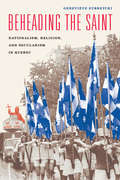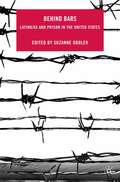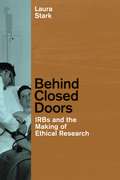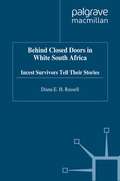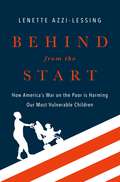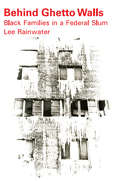- Table View
- List View
Beheading the Saint: Nationalism, Religion, and Secularism in Quebec
by Geneviève ZubrzyckiThrough much of its existence, Québec’s neighbors called it the “priest-ridden province.” Today, however, Québec society is staunchly secular, with a modern welfare state built on lay provision of social services—a transformation rooted in the “Quiet Revolution” of the 1960s. In Beheading the Saint, Geneviève Zubrzycki studies that transformation through a close investigation of the annual Feast of St. John the Baptist of June 24. The celebrations of that national holiday, she shows, provided a venue for a public contesting of the dominant ethno-Catholic conception of French Canadian identity and, via the violent rejection of Catholic symbols, the articulation of a new, secular Québécois identity. From there, Zubrzycki extends her analysis to the present, looking at the role of Québécois identity in recent debates over immigration, the place of religious symbols in the public sphere, and the politics of cultural heritage—issues that also offer insight on similar debates elsewhere in the world.
Beheading the Saint: Nationalism, Religion, and Secularism in Quebec
by Geneviève ZubrzyckiThrough much of its existence, Québec’s neighbors called it the “priest-ridden province.” Today, however, Québec society is staunchly secular, with a modern welfare state built on lay provision of social services—a transformation rooted in the “Quiet Revolution” of the 1960s. In Beheading the Saint, Geneviève Zubrzycki studies that transformation through a close investigation of the annual Feast of St. John the Baptist of June 24. The celebrations of that national holiday, she shows, provided a venue for a public contesting of the dominant ethno-Catholic conception of French Canadian identity and, via the violent rejection of Catholic symbols, the articulation of a new, secular Québécois identity. From there, Zubrzycki extends her analysis to the present, looking at the role of Québécois identity in recent debates over immigration, the place of religious symbols in the public sphere, and the politics of cultural heritage—issues that also offer insight on similar debates elsewhere in the world.
Beheading the Saint: Nationalism, Religion, and Secularism in Quebec
by Geneviève ZubrzyckiThrough much of its existence, Québec’s neighbors called it the “priest-ridden province.” Today, however, Québec society is staunchly secular, with a modern welfare state built on lay provision of social services—a transformation rooted in the “Quiet Revolution” of the 1960s. In Beheading the Saint, Geneviève Zubrzycki studies that transformation through a close investigation of the annual Feast of St. John the Baptist of June 24. The celebrations of that national holiday, she shows, provided a venue for a public contesting of the dominant ethno-Catholic conception of French Canadian identity and, via the violent rejection of Catholic symbols, the articulation of a new, secular Québécois identity. From there, Zubrzycki extends her analysis to the present, looking at the role of Québécois identity in recent debates over immigration, the place of religious symbols in the public sphere, and the politics of cultural heritage—issues that also offer insight on similar debates elsewhere in the world.
Beheading the Saint: Nationalism, Religion, and Secularism in Quebec
by Geneviève ZubrzyckiThrough much of its existence, Québec’s neighbors called it the “priest-ridden province.” Today, however, Québec society is staunchly secular, with a modern welfare state built on lay provision of social services—a transformation rooted in the “Quiet Revolution” of the 1960s. In Beheading the Saint, Geneviève Zubrzycki studies that transformation through a close investigation of the annual Feast of St. John the Baptist of June 24. The celebrations of that national holiday, she shows, provided a venue for a public contesting of the dominant ethno-Catholic conception of French Canadian identity and, via the violent rejection of Catholic symbols, the articulation of a new, secular Québécois identity. From there, Zubrzycki extends her analysis to the present, looking at the role of Québécois identity in recent debates over immigration, the place of religious symbols in the public sphere, and the politics of cultural heritage—issues that also offer insight on similar debates elsewhere in the world.
Beheading the Saint: Nationalism, Religion, and Secularism in Quebec
by Geneviève ZubrzyckiThrough much of its existence, Québec’s neighbors called it the “priest-ridden province.” Today, however, Québec society is staunchly secular, with a modern welfare state built on lay provision of social services—a transformation rooted in the “Quiet Revolution” of the 1960s. In Beheading the Saint, Geneviève Zubrzycki studies that transformation through a close investigation of the annual Feast of St. John the Baptist of June 24. The celebrations of that national holiday, she shows, provided a venue for a public contesting of the dominant ethno-Catholic conception of French Canadian identity and, via the violent rejection of Catholic symbols, the articulation of a new, secular Québécois identity. From there, Zubrzycki extends her analysis to the present, looking at the role of Québécois identity in recent debates over immigration, the place of religious symbols in the public sphere, and the politics of cultural heritage—issues that also offer insight on similar debates elsewhere in the world.
Behemoth: Main Currents in the History and Theory of Political Sociology
by Irving HorowitzThe title, Behemoth, derives from the Hebrew word Behemah-a beast, an enormous creature, monstrously huge and vast. It is an apt description of the State on the eve of the twenty-first century. Loved by few, vilified by many from all perspectives, it nonetheless continues to grow; by turns rivaling and co-opting that more pleasant-sounding word: Society. Political sociology aims to define and understand the interrelationship between these two huge terms: State and Society.Continuing in a path begun by Horowitz in the 1950s in The Idea of War and Peace in Contemporary Social and Philosophical Thought, expanded upon in the 1970s with Foundations of Political Sociology, this summing up in the late 1990s is an effort to extract and evolve the canon of political sociology. Starting with Montesquieu, Horowitz proceeds through the European experience of Rousseau, Tocqueville, Hegel, Marx, Durkheim, Sorel, and Weber. He then takes the field on its tangled migration to America with the Frankfurt School in exile, followed by searching chapters on Schumpeter, Mills, Arendt, and Huntington, among others.The result is a stunning revaluation of the intellectual sources of the present day divisions between statists and socialists, welfarists and individualists, advocates of dictatorship and of democracy, mandated rules and voluntary association, hard realists and soft utopians, a world without states and a world with a single state. Horowitz does not offer the usual evolutionary notion of doctrines, but a canon embedded in and embattled with the societies they aim to serve or overthrow in the present as in the past. The result is a major recasting of the theory and practice of social science and normative frameworks.The final chapter offers Horowitz's own prognosis of what we can expect in the recasting of the Welfare State to include the Welfare Society, and its growing nemesis the global economy which threatens to engulf State and Society alike in a return to civilizational concerns. This is an essential text for policy-makers and social scientists interested in macroscopic changes in the political order.
Behemoth: Main Currents in the History and Theory of Political Sociology
by Irving HorowitzThe title, Behemoth, derives from the Hebrew word Behemah-a beast, an enormous creature, monstrously huge and vast. It is an apt description of the State on the eve of the twenty-first century. Loved by few, vilified by many from all perspectives, it nonetheless continues to grow; by turns rivaling and co-opting that more pleasant-sounding word: Society. Political sociology aims to define and understand the interrelationship between these two huge terms: State and Society.Continuing in a path begun by Horowitz in the 1950s in The Idea of War and Peace in Contemporary Social and Philosophical Thought, expanded upon in the 1970s with Foundations of Political Sociology, this summing up in the late 1990s is an effort to extract and evolve the canon of political sociology. Starting with Montesquieu, Horowitz proceeds through the European experience of Rousseau, Tocqueville, Hegel, Marx, Durkheim, Sorel, and Weber. He then takes the field on its tangled migration to America with the Frankfurt School in exile, followed by searching chapters on Schumpeter, Mills, Arendt, and Huntington, among others.The result is a stunning revaluation of the intellectual sources of the present day divisions between statists and socialists, welfarists and individualists, advocates of dictatorship and of democracy, mandated rules and voluntary association, hard realists and soft utopians, a world without states and a world with a single state. Horowitz does not offer the usual evolutionary notion of doctrines, but a canon embedded in and embattled with the societies they aim to serve or overthrow in the present as in the past. The result is a major recasting of the theory and practice of social science and normative frameworks.The final chapter offers Horowitz's own prognosis of what we can expect in the recasting of the Welfare State to include the Welfare Society, and its growing nemesis the global economy which threatens to engulf State and Society alike in a return to civilizational concerns. This is an essential text for policy-makers and social scientists interested in macroscopic changes in the political order.
Behind Bars: Latino/as and Prison in the United States
by S. ObolerThis book addresses the complex issue of incarceration of Latino/as and offers a comprehensive overview of such topics as deportations in historical context, a case study of latino/a resistance to prisons in the 70s, the issues of youth and and girls prisons, and the post incarceration experience.
Behind Closed Doors: IRBs and the Making of Ethical Research (Morality and Society Series)
by Laura StarkAlthough the subject of federally mandated Institutional Review Boards (IRBs) has been extensively debated, we actually do not know much about what takes place when they convene. The story of how IRBs work today is a story about their past as well as their present, and Behind Closed Doors is the first book to meld firsthand observations of IRB meetings with the history of how rules for the treatment of human subjects were formalized in the United States in the decades after World War II. Drawing on extensive archival sources, Laura Stark reconstructs the daily lives of scientists, lawyers, administrators, and research subjects working—and “warring”—on the campus of the National Institutes of Health, where they first wrote the rules for the treatment of human subjects. Stark argues that the model of group deliberation that gradually crystallized during this period reflected contemporary legal and medical conceptions of what it meant to be human, what political rights human subjects deserved, and which stakeholders were best suited to decide. She then explains how the historical contingencies that shaped rules for the treatment of human subjects in the postwar era guide decision making today—within hospitals, universities, health departments, and other institutions in the United States and across the globe. Meticulously researched and gracefully argued, Behind Closed Doors will be essential reading for sociologists and historians of science and medicine, as well as policy makers and IRB administrators.
Behind Closed Doors: IRBs and the Making of Ethical Research (Morality and Society Series)
by Laura StarkAlthough the subject of federally mandated Institutional Review Boards (IRBs) has been extensively debated, we actually do not know much about what takes place when they convene. The story of how IRBs work today is a story about their past as well as their present, and Behind Closed Doors is the first book to meld firsthand observations of IRB meetings with the history of how rules for the treatment of human subjects were formalized in the United States in the decades after World War II. Drawing on extensive archival sources, Laura Stark reconstructs the daily lives of scientists, lawyers, administrators, and research subjects working—and “warring”—on the campus of the National Institutes of Health, where they first wrote the rules for the treatment of human subjects. Stark argues that the model of group deliberation that gradually crystallized during this period reflected contemporary legal and medical conceptions of what it meant to be human, what political rights human subjects deserved, and which stakeholders were best suited to decide. She then explains how the historical contingencies that shaped rules for the treatment of human subjects in the postwar era guide decision making today—within hospitals, universities, health departments, and other institutions in the United States and across the globe. Meticulously researched and gracefully argued, Behind Closed Doors will be essential reading for sociologists and historians of science and medicine, as well as policy makers and IRB administrators.
Behind Closed Doors: IRBs and the Making of Ethical Research (Morality and Society Series)
by Laura StarkAlthough the subject of federally mandated Institutional Review Boards (IRBs) has been extensively debated, we actually do not know much about what takes place when they convene. The story of how IRBs work today is a story about their past as well as their present, and Behind Closed Doors is the first book to meld firsthand observations of IRB meetings with the history of how rules for the treatment of human subjects were formalized in the United States in the decades after World War II. Drawing on extensive archival sources, Laura Stark reconstructs the daily lives of scientists, lawyers, administrators, and research subjects working—and “warring”—on the campus of the National Institutes of Health, where they first wrote the rules for the treatment of human subjects. Stark argues that the model of group deliberation that gradually crystallized during this period reflected contemporary legal and medical conceptions of what it meant to be human, what political rights human subjects deserved, and which stakeholders were best suited to decide. She then explains how the historical contingencies that shaped rules for the treatment of human subjects in the postwar era guide decision making today—within hospitals, universities, health departments, and other institutions in the United States and across the globe. Meticulously researched and gracefully argued, Behind Closed Doors will be essential reading for sociologists and historians of science and medicine, as well as policy makers and IRB administrators.
Behind Closed Doors: IRBs and the Making of Ethical Research (Morality and Society Series)
by Laura StarkAlthough the subject of federally mandated Institutional Review Boards (IRBs) has been extensively debated, we actually do not know much about what takes place when they convene. The story of how IRBs work today is a story about their past as well as their present, and Behind Closed Doors is the first book to meld firsthand observations of IRB meetings with the history of how rules for the treatment of human subjects were formalized in the United States in the decades after World War II. Drawing on extensive archival sources, Laura Stark reconstructs the daily lives of scientists, lawyers, administrators, and research subjects working—and “warring”—on the campus of the National Institutes of Health, where they first wrote the rules for the treatment of human subjects. Stark argues that the model of group deliberation that gradually crystallized during this period reflected contemporary legal and medical conceptions of what it meant to be human, what political rights human subjects deserved, and which stakeholders were best suited to decide. She then explains how the historical contingencies that shaped rules for the treatment of human subjects in the postwar era guide decision making today—within hospitals, universities, health departments, and other institutions in the United States and across the globe. Meticulously researched and gracefully argued, Behind Closed Doors will be essential reading for sociologists and historians of science and medicine, as well as policy makers and IRB administrators.
Behind Closed Doors: IRBs and the Making of Ethical Research (Morality and Society Series)
by Laura StarkAlthough the subject of federally mandated Institutional Review Boards (IRBs) has been extensively debated, we actually do not know much about what takes place when they convene. The story of how IRBs work today is a story about their past as well as their present, and Behind Closed Doors is the first book to meld firsthand observations of IRB meetings with the history of how rules for the treatment of human subjects were formalized in the United States in the decades after World War II. Drawing on extensive archival sources, Laura Stark reconstructs the daily lives of scientists, lawyers, administrators, and research subjects working—and “warring”—on the campus of the National Institutes of Health, where they first wrote the rules for the treatment of human subjects. Stark argues that the model of group deliberation that gradually crystallized during this period reflected contemporary legal and medical conceptions of what it meant to be human, what political rights human subjects deserved, and which stakeholders were best suited to decide. She then explains how the historical contingencies that shaped rules for the treatment of human subjects in the postwar era guide decision making today—within hospitals, universities, health departments, and other institutions in the United States and across the globe. Meticulously researched and gracefully argued, Behind Closed Doors will be essential reading for sociologists and historians of science and medicine, as well as policy makers and IRB administrators.
Behind Closed Doors: IRBs and the Making of Ethical Research (Morality and Society Series)
by Laura StarkAlthough the subject of federally mandated Institutional Review Boards (IRBs) has been extensively debated, we actually do not know much about what takes place when they convene. The story of how IRBs work today is a story about their past as well as their present, and Behind Closed Doors is the first book to meld firsthand observations of IRB meetings with the history of how rules for the treatment of human subjects were formalized in the United States in the decades after World War II. Drawing on extensive archival sources, Laura Stark reconstructs the daily lives of scientists, lawyers, administrators, and research subjects working—and “warring”—on the campus of the National Institutes of Health, where they first wrote the rules for the treatment of human subjects. Stark argues that the model of group deliberation that gradually crystallized during this period reflected contemporary legal and medical conceptions of what it meant to be human, what political rights human subjects deserved, and which stakeholders were best suited to decide. She then explains how the historical contingencies that shaped rules for the treatment of human subjects in the postwar era guide decision making today—within hospitals, universities, health departments, and other institutions in the United States and across the globe. Meticulously researched and gracefully argued, Behind Closed Doors will be essential reading for sociologists and historians of science and medicine, as well as policy makers and IRB administrators.
Behind Closed Doors: Violence in the American Family
by Murray A. Straus Richard J. Gelles Suzanne K. SteinmetzThe marriage license as a hitting license, child abuse, sibling war is the powerful message of "Behind Closed Doors". The book is grounded in the unprecedented national survey of the extent, patterns, and causes of violence in the American family. Based on a seven-year study of over 2,000 families, the authors provide landmark insights into this phenomenon of violence and what causes Americans to inflict it on their family members. The authors explore the relationship between spousal abuse and child abuse as well as abuse between siblings, violence by children against their parents, and the causes and effects of verbal abuse. Taken together, their analysis provides a vivid picture of how violence is woven into the fabric of family life and why the hallmark of family life is both love and violence. This is a comprehensive, highly readable account of interest to both the professional and the lay-person on an important topic, which concerns the social well-being of us all.
Behind Closed Doors: Violence in the American Family
by Murray A. Straus Richard J. Gelles Suzanne K. SteinmetzThe marriage license as a hitting license, child abuse, sibling war is the powerful message of "Behind Closed Doors". The book is grounded in the unprecedented national survey of the extent, patterns, and causes of violence in the American family. Based on a seven-year study of over 2,000 families, the authors provide landmark insights into this phenomenon of violence and what causes Americans to inflict it on their family members. The authors explore the relationship between spousal abuse and child abuse as well as abuse between siblings, violence by children against their parents, and the causes and effects of verbal abuse. Taken together, their analysis provides a vivid picture of how violence is woven into the fabric of family life and why the hallmark of family life is both love and violence. This is a comprehensive, highly readable account of interest to both the professional and the lay-person on an important topic, which concerns the social well-being of us all.
Behind Closed Doors in White South Africa: Incest Survivors Tell their Stories
by D. RussellThe intent in this book is to tear away the veil of secrecy that surrounds incestuous abuse in white South Africa by presenting five in-depth personal accounts of this heinous form of sexual exploitation as told by the survivors. Each of these accounts includes an analysis of important incest-related issues raised by the survivor's story. Another objective is to explore the connections between the often cruel sexual exploitation of girls by their white male relatives and the brutal exploitation of black people by white men in South Africa.
Behind from the Start: How America's War on the Poor is Harming Our Most Vulnerable Children
by Lenette Azzi-LessingToday there are nearly six million children under the age of five living in poverty in the world's richest country. Blanket statements are often tossed around in the political arena, public debate sphere, and progressive rhetoric. But the statistic remains intangible for many Americans, likely because the root causes, effects, and implications are multifaceted and complex, and are often hard to understand for the average American living a much different reality. What is needed is a clear and thorough discussion of this epidemic, and Behind from the Start answers that call. Author Lenette Azzi-Lessing examines what lies behind the stubbornly high rate of poverty among young children in the U.S. and the resulting consequences, both for the children themselves and for America as a whole. Behind from the Start examines the link between America's shaming, blaming, and marginalizing of poor parents, and our punitive welfare policies that jeopardize the life chances of vulnerable young children, thereby maintaining the cycle of chronic poverty. Research has shown that the experience of poverty in the first years of life is particularly harmful, blunting physical and brain development, increasing the risk for chronic health issues and injury, and limiting a person's lifelong capacity for learning and success. In debunking the myths that help perpetuate the cycle of poverty in the world's richest country, Lenette Azzi-Lessing reveals how negative public and political discourse regarding poor families impacts the poorly conceived and fragmented programs intended to support them, which have in turn failed to meet their aims. She considers the cultural and political forces that contribute to intergenerational poverty in the U.S., the consequences for the millions of young children in families stuck at the bottom of our economy, and the beneficial impacts that would be felt country-wide in fixing some of these persistent problems. Drawing upon knowledge from diverse fields, including neuroscience, media studies, and public policy, as well as the author's experiences on the front lines as a practicing social worker, Behind from the Start offers a fresh take on this shameful problem and its solutions.
Behind from the Start: How America's War on the Poor is Harming Our Most Vulnerable Children
by Lenette Azzi-LessingToday there are nearly six million children under the age of five living in poverty in the world's richest country. Blanket statements are often tossed around in the political arena, public debate sphere, and progressive rhetoric. But the statistic remains intangible for many Americans, likely because the root causes, effects, and implications are multifaceted and complex, and are often hard to understand for the average American living a much different reality. What is needed is a clear and thorough discussion of this epidemic, and Behind from the Start answers that call. Author Lenette Azzi-Lessing examines what lies behind the stubbornly high rate of poverty among young children in the U.S. and the resulting consequences, both for the children themselves and for America as a whole. Behind from the Start examines the link between America's shaming, blaming, and marginalizing of poor parents, and our punitive welfare policies that jeopardize the life chances of vulnerable young children, thereby maintaining the cycle of chronic poverty. Research has shown that the experience of poverty in the first years of life is particularly harmful, blunting physical and brain development, increasing the risk for chronic health issues and injury, and limiting a person's lifelong capacity for learning and success. In debunking the myths that help perpetuate the cycle of poverty in the world's richest country, Lenette Azzi-Lessing reveals how negative public and political discourse regarding poor families impacts the poorly conceived and fragmented programs intended to support them, which have in turn failed to meet their aims. She considers the cultural and political forces that contribute to intergenerational poverty in the U.S., the consequences for the millions of young children in families stuck at the bottom of our economy, and the beneficial impacts that would be felt country-wide in fixing some of these persistent problems. Drawing upon knowledge from diverse fields, including neuroscience, media studies, and public policy, as well as the author's experiences on the front lines as a practicing social worker, Behind from the Start offers a fresh take on this shameful problem and its solutions.
Behind Ghetto Walls: Black Families in a Federal Slum
by Michael NovakThis book is about the family lives of some 10,000 children and adults who live in an all-Negro public housing project in St Louis. The Pruitt-Igoe project is only one of the many environments in which urban Negro Americans lived in the 1960s, but the character of the family life there shares much with the family life of lower-class Negroes as it has been described by other investigators in other cities and at other times, in Harlem, Chicago, New Orleans, or Washington D.C. This book is primarily concerned with private life as it is lived from day to day in a federally built and supported slum. The questions, which are treated here, have to do with the kinds of interpersonal relationships that develop in nuclear families, the socialization processes that operate in families as children grow up in a slum environment, the informal relationships of children and adolescents and adults with each other, and, finally, the world views (the existential framework) arising from the life experiences of the Pruitt-Igoeans and the ways they make use of this framework to order their experiences and make sense out of them. The lives of these persons are examined in terms of life cycles. Each child there is born into a constricted world, the world of lower class, Negro existence, and as he grows he is shaped and directed by that existence through the day-to-day experiences and relationships available to him. The crucial transition from child of a family; to progenitor of a new family begins in adolescence, and for this reason the book pays particular attention to how each new generation of parents expresses the cultural and social structural forces that formed it and continue to constrain its behavior. This book, in short, is about intimate personal life in a particular ghetto setting. It does not analyze the larger institutional, social structural, and ideological forces that provide the social, economic, and political context in which lower-class Negro life is lived. These larger macro sociological forces are treated in another volume based on research in the Pruitt-Igoe community. However, this book does draw on the large body of literature on the structural position of Negroes in American society as background for its analysis of Pruitt-Igoe private life.
Behind Ghetto Walls: Black Families in a Federal Slum
by Michael NovakThis book is about the family lives of some 10,000 children and adults who live in an all-Negro public housing project in St Louis. The Pruitt-Igoe project is only one of the many environments in which urban Negro Americans lived in the 1960s, but the character of the family life there shares much with the family life of lower-class Negroes as it has been described by other investigators in other cities and at other times, in Harlem, Chicago, New Orleans, or Washington D.C. This book is primarily concerned with private life as it is lived from day to day in a federally built and supported slum. The questions, which are treated here, have to do with the kinds of interpersonal relationships that develop in nuclear families, the socialization processes that operate in families as children grow up in a slum environment, the informal relationships of children and adolescents and adults with each other, and, finally, the world views (the existential framework) arising from the life experiences of the Pruitt-Igoeans and the ways they make use of this framework to order their experiences and make sense out of them. The lives of these persons are examined in terms of life cycles. Each child there is born into a constricted world, the world of lower class, Negro existence, and as he grows he is shaped and directed by that existence through the day-to-day experiences and relationships available to him. The crucial transition from child of a family; to progenitor of a new family begins in adolescence, and for this reason the book pays particular attention to how each new generation of parents expresses the cultural and social structural forces that formed it and continue to constrain its behavior. This book, in short, is about intimate personal life in a particular ghetto setting. It does not analyze the larger institutional, social structural, and ideological forces that provide the social, economic, and political context in which lower-class Negro life is lived. These larger macro sociological forces are treated in another volume based on research in the Pruitt-Igoe community. However, this book does draw on the large body of literature on the structural position of Negroes in American society as background for its analysis of Pruitt-Igoe private life.
Behind the Eight Ball: Sex for Crack Cocaine Exchange and Poor Black Women
by Tanya Telfair SharpeInner-city black women open their hearts to share the pain of crack addiction and its consequences Behind the Eight Ball: Sex for Crack Cocaine Exchange and Poor Black Women documents an American tragedy that highlights the widening gap between social and economic classes. In their own words, poor black women-nameless, faceless, and marginalized by poverty-share the details of their lives before and after crack cocaine invaded their communities, each recalling the circumstances of her introduction to the drug and her first experience using sex to support her addiction. These candid interviews expose the socioeconomic changes in inner-city neighborhoods that created the perfect conditions for a crack stronghold; the crack cocaine economy's impact on the lives of inner-city residents; and the social and familial consequences of crack addiction among poor, black women. Behind the Eight Ball: Sex for Crack Cocaine Exchange and Poor Black Women places crack addiction, crack-related prostitution and its consequences, STDs, HIV, and pregnancy into the context of the larger social issues of inner-city poverty, race, gender, and class. This unique book reveals the sex-for-crack barter system as evidence of a long-term social exclusion and systemic racism that has worked to destroy the self-image of poor black American women. The women interviewed reflect this negative image, exchanging sex for crack on a regular basis to support their addictions at the risk-and reality-of unplanned pregnancies. "The baby I am carrying now, I don&’t know who the father is. There are a few (men) that I had sex with around the time I got pregnant-that day. But which one it is, I don&’t know who."Behind the Eight Ball: Sex for Crack Cocaine Exchange and Poor Black Women examines: why poor black women addicted to crack are disproportionately at risk for sexually transmitted diseases, including HIV, and unplanned pregnancies how the social and economic characteristics of poor black communities support crack distribution and consumption how crack use and the exchange of sex for crack damages struggling black families why the care of many children is entrusted to child welfare agencies how and why women are marginalized in the crack cultureBehind the Eight Ball: Sex for Crack Cocaine Exchange and Poor Black Women is an insightful and enlightening look at the motivations behind the decision to risk illness, injury, disease, death, and pregnancy to support addiction.
Behind the Eight Ball: Sex for Crack Cocaine Exchange and Poor Black Women
by Tanya Telfair SharpeInner-city black women open their hearts to share the pain of crack addiction and its consequences Behind the Eight Ball: Sex for Crack Cocaine Exchange and Poor Black Women documents an American tragedy that highlights the widening gap between social and economic classes. In their own words, poor black women-nameless, faceless, and marginalized by poverty-share the details of their lives before and after crack cocaine invaded their communities, each recalling the circumstances of her introduction to the drug and her first experience using sex to support her addiction. These candid interviews expose the socioeconomic changes in inner-city neighborhoods that created the perfect conditions for a crack stronghold; the crack cocaine economy's impact on the lives of inner-city residents; and the social and familial consequences of crack addiction among poor, black women. Behind the Eight Ball: Sex for Crack Cocaine Exchange and Poor Black Women places crack addiction, crack-related prostitution and its consequences, STDs, HIV, and pregnancy into the context of the larger social issues of inner-city poverty, race, gender, and class. This unique book reveals the sex-for-crack barter system as evidence of a long-term social exclusion and systemic racism that has worked to destroy the self-image of poor black American women. The women interviewed reflect this negative image, exchanging sex for crack on a regular basis to support their addictions at the risk-and reality-of unplanned pregnancies. "The baby I am carrying now, I don&’t know who the father is. There are a few (men) that I had sex with around the time I got pregnant-that day. But which one it is, I don&’t know who."Behind the Eight Ball: Sex for Crack Cocaine Exchange and Poor Black Women examines: why poor black women addicted to crack are disproportionately at risk for sexually transmitted diseases, including HIV, and unplanned pregnancies how the social and economic characteristics of poor black communities support crack distribution and consumption how crack use and the exchange of sex for crack damages struggling black families why the care of many children is entrusted to child welfare agencies how and why women are marginalized in the crack cultureBehind the Eight Ball: Sex for Crack Cocaine Exchange and Poor Black Women is an insightful and enlightening look at the motivations behind the decision to risk illness, injury, disease, death, and pregnancy to support addiction.
Behind the Executive Door: Unexpected Lessons for Managing Your Boss and Career
by Karol M. WasylyshynSigmund Freud meets Peter Drucker … Behind the Executive Door is a revealing look at the behavior of top business leaders—and how the next level of aspiring managers can learn to navigate the political and personal landscape. Based on over 25 years of psychotherapy and consulting experiences, as well as extensive empirical research, Karol Wasylyshyn has identified a dynamic continuum of executive behaviors that are manifested in three specific types of business leaders – Remarkable, Perilous, and Toxic. She describes these types in accessible terms with the intertwined goals of helping readers (1) recognize these behaviors and leadership types and (2) leverage this information to increase their savvy and effectiveness in the workplace. In the wake of Sarbanes-Oxley and the increased scrutiny of business executives, we have learned that how they lead is often their undoing – or at least it is a pressing development need and/or potential derailment factor. In short, despite financial or strategic smarts, ineffective leadership behavior de-motivates talented employees, has adverse effects on productivity, and jeopardizes positive business results. Conversely, we can recognize the qualities of effective leadership behavior, which is largely a function of emotional intelligence, the ability to tap into the needs and motivations of others and bring out their best performance. In Behind the Executive Door, the author provides a wide variety of tools and exercises to help the reader identify the behavior traits of their organizations’ leaders –and hone their own approaches to achieve positive results. In the process, readers will also gain insights and skills to manage laterally and down, as well as up the organizational ladder. The concepts can be applied in any type of organization – private or public, for-profit or non-profit. The result is not only a better understanding of organizational politics and leadership behavior, but a practical guide to making important career decisions, such as whom to work for and how to develop one’s own leadership style.
Behind the Fog: How the U.S. Cold War Radiological Weapons Program Exposed Innocent Americans
by Lisa Martino-TaylorBehind the Fog is the first in-depth, comprehensive examination of the United States’ Cold War radiological weapons program. The book examines controversial military-sponsored studies and field trials using radioactive "simulants" that exposed American civilians to radiation and other hazardous substances without their knowledge or consent during the Cold War. Although Western biological and chemical weapons programs have been analyzed by a number of scholars, Behind the Fog is a strong departure from the rest in that the United States radiological weapons program has been generally unknown to the public. Martino-Taylor documents the coordinated efforts of a small group of military scientists who advanced a four-pronged secret program of human-subject radiation studies that targeted unsuspecting Americans for Cold War military purposes. Officials enabled such projects to advance through the layering of secrecy, by embedding classified studies in other studies, and through outright deception. Agency and academic partnerships advanced, supported, and concealed the studies from the public at large who ultimately served as unwitting test subjects. Martino-Taylor’s comprehensive research illuminates a dark chapter of government secrecy, the military-industrial-academic complex, and large-scale organizational deviance in American history. In its critical approach, Behind the Fog effectively examines the mechanisms that allow large-scale elite deviance to take place in modern society.
